Okay, friends. I have to take a deep breath first…and apologize for how I’ve been utterly absent from Day7Kitchen for the past month and a half. I know that I promised to blog while in Beijing, I know I vowed to schedule blog posts while I was on the other side of the globe, but… I failed. I blame it on all that Beijing had to offer, all the second wedding reception craziness, the nightly outings Y and I had with old friends, and most of all, the endless sea of Chinese food that filled my stomach and my mind 99% of the time. Okay I admit, that was a bit shameless. Knowing that you are probably most interested in the last part of that sentence, I will dedicate this post to introducing some traditional Beijing dishes and street snacks. Alas, I’ve redeemed myself.
But first, the back story of my absence. I went to Beijing in April for a month to do an away rotation at a pediatric hospital there, out of my long brewing interest in the Chinese healthcare system. In between, Y and I also held our second wedding reception there, mostly with his side of the family and friends. We took Asian-style “wedding glamour shots” as I call them (I will dedicate another post to this hilarity, don’t worry, it’s coming). And we managed to see most of our old friends in Beijing left from the year when I last lived there, also when Y and I met. Anyhow, back to business. While we were there, the frequent dinner outings meant that we got to sample lots of Beijing cuisines. Here are some of the most memorable and nostalgic dishes.
JianBing, or Beijing fried pancake. Though it’s commonly referred to as a pancake, this popular snack resembles more like a folded crepe. If you go out onto the streets of Beijing, almost on any corner, you’ll spot these JianBing street stalls, especially at breakfast time, where the pancake is made hot and fresh in front of you. The auntie rolls the crepe mix out into a perfect circle onto a giant round sizzling cast iron plate, then cracks an egg onto the center, spreads it round with a flat spatula. She waits for several seconds then flips the crepe over with practiced precision and brushes savory sauce and chili paste onto the crepe. Then she waits a couple more seconds for the bottom side of the crepe to crisp up, and she scatters chopped green onions and cilantro on the crepe, places a fried dough crisp onto the center and folds the rest of the crepe up around the fried dough crisp. She hands you the paper-wrapped JianBing, and you hand her a 5RMB bill, and voila, a culinary exchange is made. It’s quite a mesmerizing scene to watch. The first chance I had to stop by a street stall, I got myself a steaming JianBing and refreshed this nostalgic experience.
LuZhu, or pork intestine stew, is another cheap bite popular among old Beijingers since the 19th century. This dish’s name does fend away most who are foreign to the capital city, but don’t let its concept scare you. It’s a Beijing delicacy made in a large pot stewing pork intestine, lung, tofu and naan all in one. The intestines are stewed slowly but surely for many hours. They are slightly chewy and very flavorful, and the lung slivers are also savory and melts in your mouth. The stew is served in a bowl, topped with chopped cilantro, commonly with a side of hot sesame buns. It took me awhile to get used to this dish, but once I did, I found it heart warming and full of umami. Being able to enjoy luzhu means that you’ve been inducted into the unspoken circle of old Beijingers and the hundreds of years of tradition and culture that shrouds this city. Note: do not attempt to make this at home, since there are certain sanitary standards that are hard to meet in your kitchen.
Charcoal barbecue is something I tried for the first time on this trip. It’s a form of barbecue that uses charcoal to fuel the round cast iron grill. The flavor of the charcoal itself steeps into the meat and vegetable that is cooked and gives it a mature and rounded taste. You can grill a variety of thinly sliced beef, pork, lamb, pig ears, tripes, intestines, pork liver, as well as fish, shellfish, shiitake mushroom, enoki mushroom, onions, sweet potato, etc. In the winter, you will find these charcoal barbecue joints lining up the streets of the old city, and families huddled around the round grill, enjoying each other’s company over the heartwarming atmosphere that sharing barbecued foods creates.
I’ll cut it short today and end the street snack introductions here, but look out for part two in the next blog post, where I will introduce another three dishes!
In the spirit of this discussion, we cannot but have some Chinese food recipes while we are at it. Though this szechuan stir-fried cabbage is not from Beijing, it is found in almost every restaurant in the city because it’s been popularized everywhere in China. To make this dish, use green cabbage, not napa cabbage or savoy cabbage, and make sure to rip the cabbage pieces with your hands instead of cutting the leaves! The Chinese name of this dish actually translates to “hand-ripped sautee cabbage” because the flavor soaks in better when it’s ripped by hand.
Szechuan Cabbage
Ingredients:
- green cabbage, washed and hand ripped into small pieces
- 3-5 pieces of dry red chili pepper
- small piece of pork belly, cut into thin slices
- 2 cloves of garlic, smashed
- 2 slices of ginger
- 1/2 Tbsp oyster sauce
- 1 Tbsp light soy sauce
- 2 tbsp Chinese vinegar
- 1 tbsp sesame oil or szechuan peppercorn oil
In a large pan, saute pork belly slice in canola oil until meat turns from red to white. Add dry red chili, ginger, garlic, and stir fry over medium heat for 3 minutes. The pork belly slices should be golden at this point.
Add hand ripped cabbage pieces. Add in salt, soy sauce, vinegar and oyster sauce. Saute over medium heat for another 5-7 minutes until cabbage is softened.
Drizzle sesame oil or szechuan peppercorn oil. Plate the contents and enjoy over a bowl of rice!


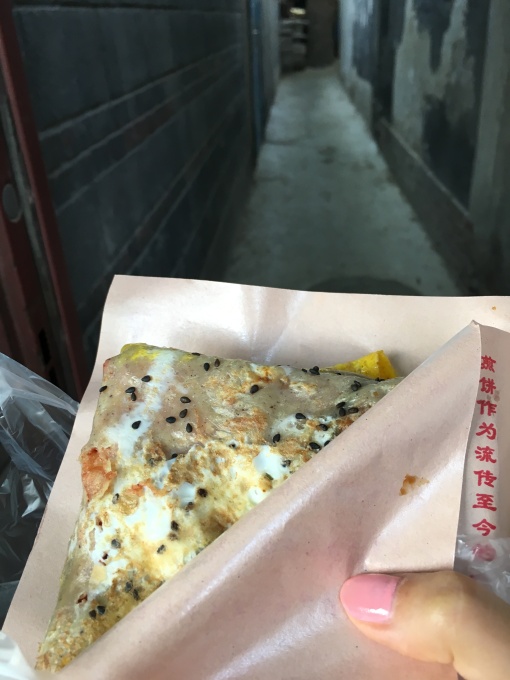

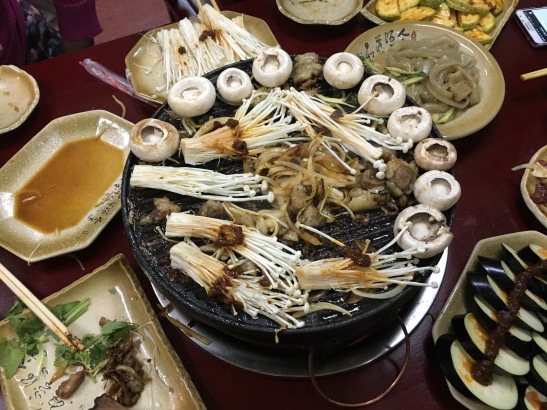
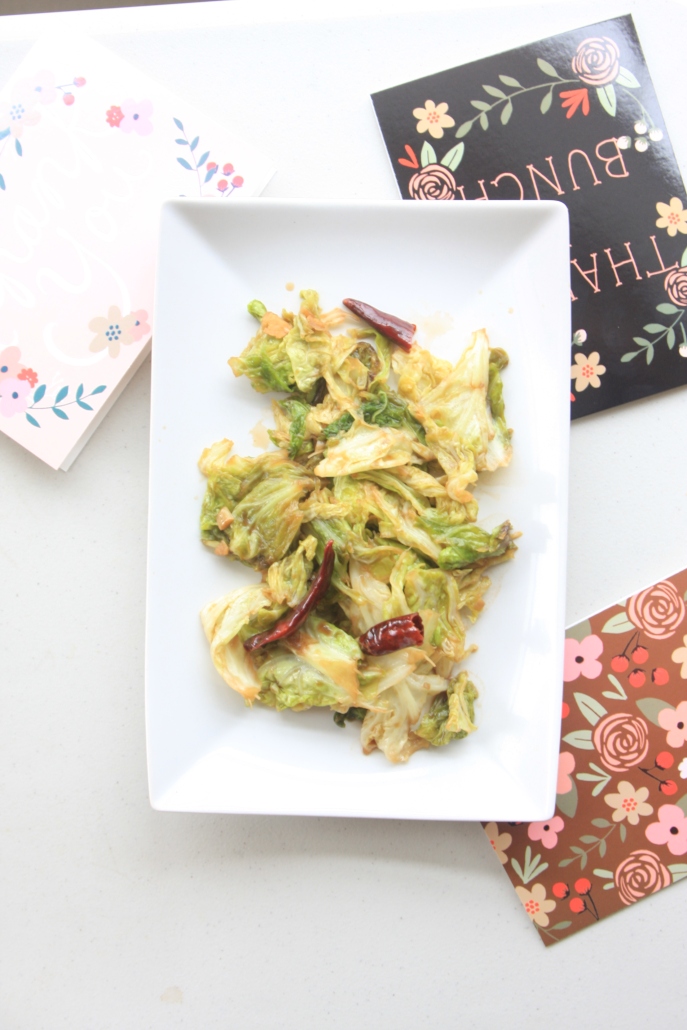
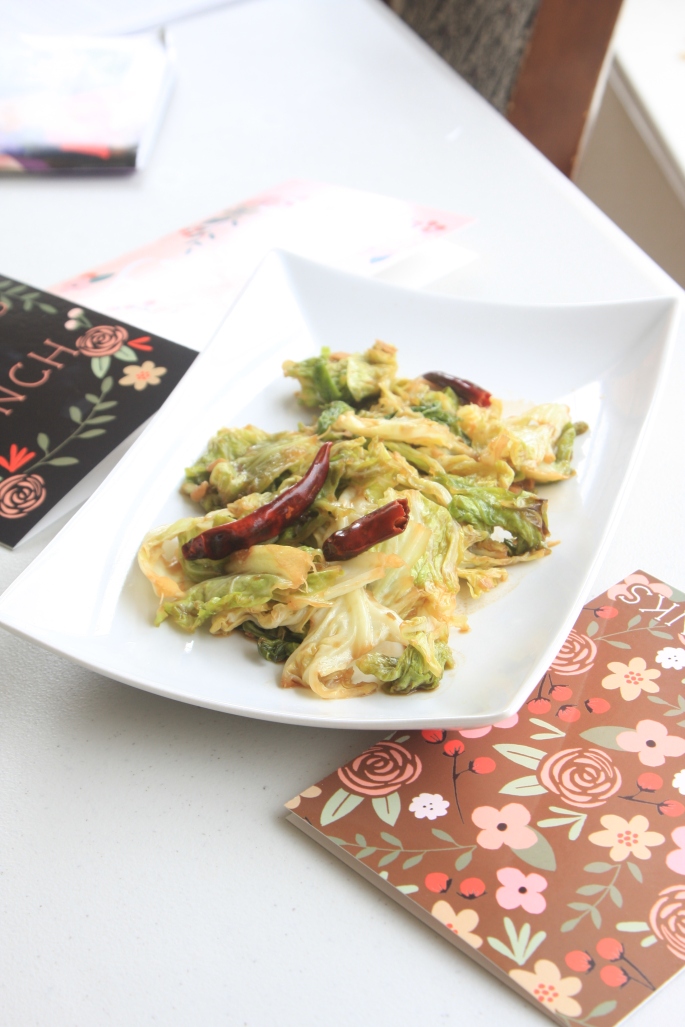
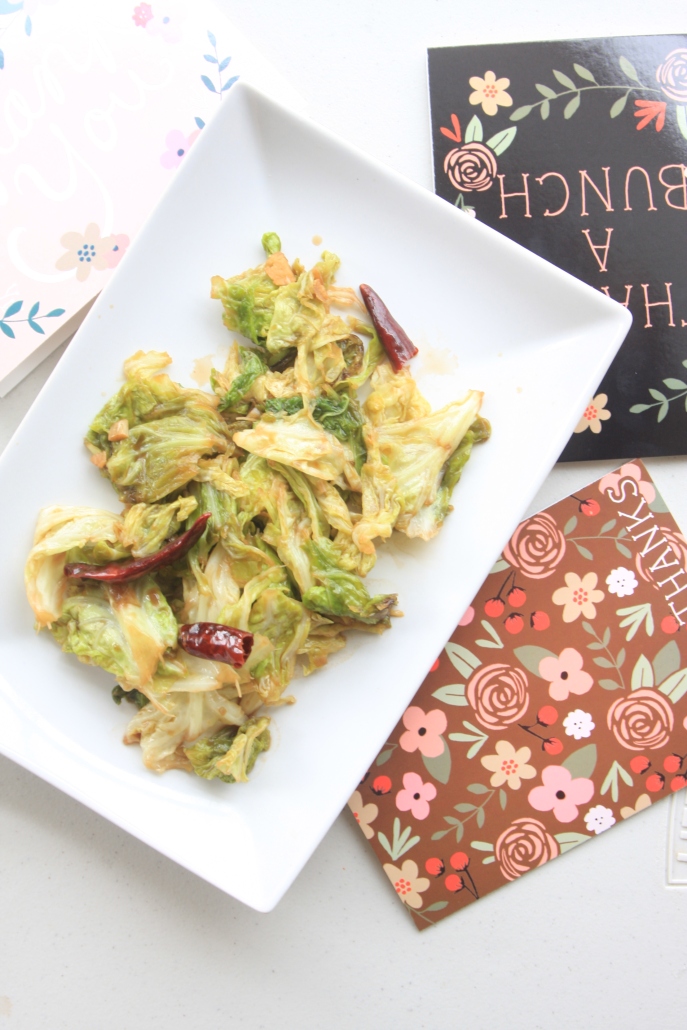
I can make this too
LikeLike